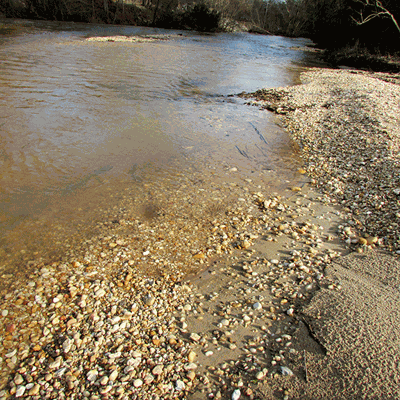Having grown up at Elmore Station in west Elmore County, I spent the majority of my youth swimming in, fishing on and camping around Mortar Creek. The creek runs through the heart of the town and extends almost the full length of west Elmore County.
The creek’s headwaters are north of the Town of Deatsville. From there, it flows south through Deatsville, Speigner and Elmore and enters the Alabama River at its mouth near present day Coosada.
Mortar Creek is historically known for its white sand and beautiful white and various colored flint stones. During the early and mid 20th century, Mortar Creek was a haven for family picnics and swimming parties and a magnet for energetic young boys seeking an adventure; however, few people today know its historical significance to the development of not just Elmore County but also to Alabama and the United States. Mortar Creek was a natural draw for Native Americans and, later, pioneers in search of new life on the frontier.
Alabama is named after the Alibamos Indians that settled at Koseati (present day Coosada) in the 16th century around 1520-1535. They found the place good, and they prospered here. Their settlement expanded throughout the area, including Mortar Creek with the white sand and the perfect material to make arrow points and other tools.
In 1722, the chief at Coosawda (one of several early spellings) was named “Big Mortar.” Although not sounding Native American, sources say that Mortar Creek is named after the Indian Chief Big Mortar. Evidence of early Indian settlements, all along the creek, could be found today if one looks closely enough.
Shortly after the Alabama Territory was opened in 1817, General John Archer Elmore, a well respected general in the American Revolution and the person for whom Elmore County is named, moved from South Carolina to establish a plantation and homestead on the banks of Mortar Creek. His home and plantation were originally in Autauga County but later became Elmore County when it was established in 1866 from parts of Coosa, Tallapoosa, Autauga and Montgomery counties.
Elmore’s land grant was substantial, based on his authority, reputation and service during the Revolutionary War of Independence from England. He could have selected any location in the state, but he saw something special in the plantation site he named Huntingdon at Mortar Creek. Huntingdon provided excellent soil in which to grow cotton and the ability to transport it to markets down the Alabama River.
General Elmore’s family was large with 19 children. His descendants’ contributions to the development of Elmore County, Alabama, and the United States at large are monumental and well documented in the evolution of our country. In 1827, one of his daughters married her neighbor, the Honorable Benjamin Fitzpatrick, former Governor of Alabama, U.S. Senator and United States Vice Presidential nominee, although he declined the nomination in support of secession of his home state at the start of the Civil War. Fitzpatrick’s plantation adjoined General Elmore’s, and they together established the community of Elmore, which now is the Town of Elmore.
Another historical event occurred on Mortar Creek, as well. Daniel Pratt, who was born in Temple, New Hampshire, in 1799, was an architect and builder by trade. He migrated south to Georgia in 1819, where he partnered with Samuel Griswold and learned to build cotton gins. He persuaded Griswold to establish a branch factory in central Alabama, but Griswold changed his mind due to reported Indian uprisings in the area.
Pratt was determined to carry out the plan and brought materials to Alabama in 1833 to build 50 gins. He established his factory temporarily on Mortar Creek near the community of Elmore, where he assembled the 50 gins. The gins sold very quickly to local planters, and he wanted to establish a more permanent location.
The story goes that he approached General Elmore to lease some of his land on Mortar Creek because he needed the water supply and more space. The General turned him down, so Pratt moved further west and leased property on Autauga Creek near McNeil’s Mill. There, he produced an average of 200 gins annually. He purchased land in 1835 to expand his company and moved the gin factory to a new location, where he proceeded to build a town modeled after New England’s mill towns.
That town came to be known as Prattville after its founder, Daniel Pratt. A permanent brick building was built in 1854 and stands today in the heart of Prattville, Alabama. The Pratt Gin Company became the largest gin factory in the world.
Present day Mortar Creek continues to flow from its headwaters to its mouth at the Alabama River. It looks a little tired as I cross over the Highway 143/14 bridge approaching the Town of Elmore. Trees and undergrowth seem to have taken over the beaches and the sand shoals of my youth, and that makes me a little sad.
On the other hand, I smile and chuckle at the happy memories of my youth there and am amazed at the historical significance of a creek that flows through a small town in west Elmore County, Alabama, and I think “what a wonderful world.” I am so blessed to have grown up near Mortar Creek.






